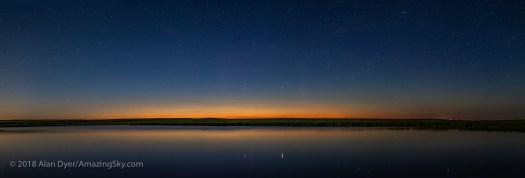
Solstice nights have been filled with twilights, planets, and noctilucent clouds.
Astronomers tend to curse the short nights and late sunsets of summer solstice. But the bright nights do offer unique sights.
Over the last few nights I’ve set up at what I call “Solstice Pond,” a prairie slough near home ideal for shooting the aurora to the north and, at this time of year, the glow of twilight and noctilucent clouds.
Below is the view on the night before solstice, looking north toward the glow of “perpetual twilight” that lights the northern horizon at solstice time from my latitude of 50° north.

From farther north the twilight would be more prominent, while above the Arctic Circle at 66° N latitude, the twilight turns to full daylight as the Sun never sets.
The view looking south this night, with the Moon just off frame at right, includes the Milky Way at centre, with Saturn embedded, flanked by bright Jupiter at right and reddish Mars at left, both casting shimmering “glitter paths” on the still waters.

A few nights later (below), on June 24, the star of the solstice sky put in an appearance. Bright noctilucent clouds (NLCs) shone to the north, reflected in the pond.
These are water vapour clouds 80 kilometres high at the edge of the atmosphere – in the mesosphere – almost in space. They form over the Arctic in summer, and are high enough to remain sunlit even in the middle of the night as they catch the Sun shining over the pole.
Southern Western Canada – the Prairies where I live – is well-placed to see them, as we are far enough north to see them in our sky, but not so far north that our sky is too bright.

An even better display appeared two nights later, on June 26, brighter and with more structure.
The curving arc of the top of the display defines the most southerly edge where sunlight is able to reach. That edge drops lower through the first part of the night, as the Sun itself drops lower below the horizon. This causes less of the NLC display to be sunlit.

You can see this effect of the changing illumination of the clouds in this time-lapse compilation from June 26 (below).
Also notice the waving motion of the clouds. It is as if the NLC material is flowing over standing waves in the atmosphere – and it is! The waves are called “gravity waves,” and are bumps in the high atmosphere created by disturbances far below in the normal layers of the atmosphere, the stratosphere and troposphere.
The video includes two clips shot simultaneously: from a camera with a 24mm wide-angle lens, and from a camera with an 85mm moderate telephoto. Expand to view full screen in HD.
The motion, here over an hour or more, is hypnotic. The NLCs move right to left (east to west), while the dark normal weather clouds on the horizon are blowing left to right (west to east). The stars are also turning left to right. The water ripples in the wind, while ducks swim by.
It was a magical night at Solstice Pond.
– Alan, June 27, 2018 / © 2018 Alan Dyer / AmazingSky.com


Hello Alan. You have beautiful works. Thank you for your photos. I also shoot a night landscape and especially about the silvery clouds. Enjoy your viewing. Filmed near Moscow in Russia.
https://yadi.sk/i/9r3vSigA3YY8rb